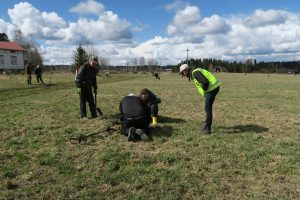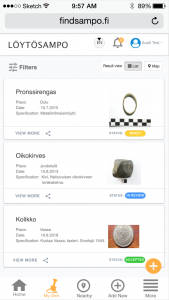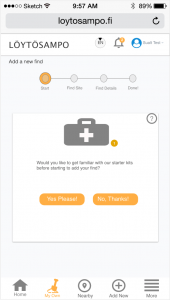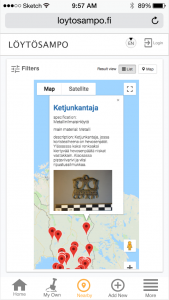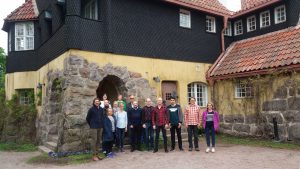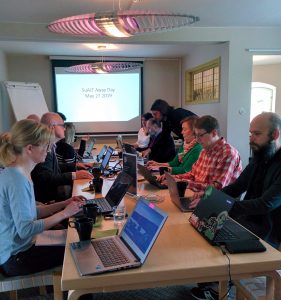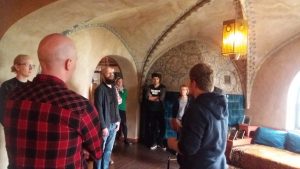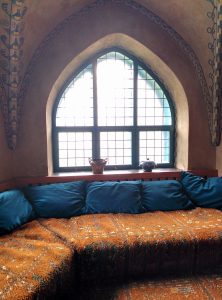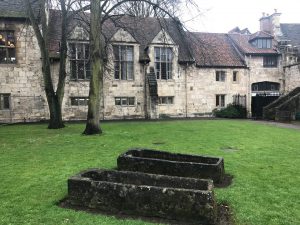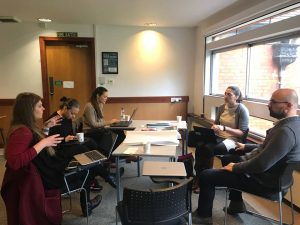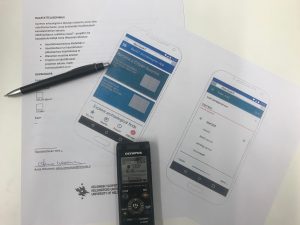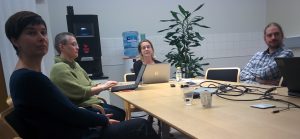Viime lauantaina projektimme kävi kentällä testaamassa Löytösammon prototyyppiä. Mukana oli myös kolme metallinetsinharrastajaa, Matti Mölsä, Anssi Puisto ja Anssi Vuohelainen, jotka olivat lupautuneet testaamaan käyttösovellusta kanssamme. Anna Wessman oli sosiaalisen median kautta etsinyt vapaaehtoisia testaajia. Koska kiinnostuneita ilmoittautui paljon, valitsimme testaajiksi kolme ensimmäiseksi ilmoittautunutta.

Vasemmalta: Matti Mölsä, Anssi Puisto, Pejam Hassanzadeh sekä Anssi Vuohelainen. Kuva/Photo: Helinä Parviainen
Esittelyn ja ohjeistuksen jälkeen Pejam Hassanzadeh jakoi testilinkin ja siirryimme pellolle. Pyysimme testaajia tallentamaan kaiken löytämänsä, jopa ruosteiset naulat, koska oli tärkeätä nähdä miten Löytösampo toimii kenttäolosuhteissa.
Jokaisella harrastajalla oli joko Anna Wessman, Helinä Parviainen tai Suzie Thomas seuranaan, jotka äänittivät kaikki kommentit Löytösammosta. Lisäksi oli tärkeää saada äänitettyä koko tallennusprosessi, jotta huomaisimme missä korjattavia ongelmia vielä on (kuten sellaiset tallennuksen vaiheet, jotka kestävät liian kauan). Ville Rohiola dokumentoi tapahtuman valokuvaamalla. Pejam Hassanzadeh, Mikko Koho ja Jouni Tuominen tarkkailivat kuinka sovellus toimii ja auttoivat teknisissä kysymyksissä.

Jouni ja Mikko testaamassa metallinetsimen käyttöä. Kuva/Photo: Ville Rohiola.
Mikko ja Jouni myös kokeilivat metallinetsintää itse laitteilla, jotka olimme lainanneet yliopiston arkeologian oppiaineesta. Tällä tavalla saimme todellisten aloittelijoiden testikokemuksia hyödyntäen samalla myös metallinetsijöiden asiantuntijuutta laitteiden käytössä! Mikko ja Jouni jatkavat sovelluksen testaamista ensi viikolla Aalto-yliopiston Otaniemen kampuksella, joten he lainaavat metallinetsimiä hiukan pidempään.
Palauteet auttoivat osoittamaan Löytösammossa olevia ongelmia. Niiden avulla voimme jatkokehittää sovellusta. Esimerkiksi löydöistä otettujen valokuvien tallentaminen tietokantaan kestää edelleen liian kauan. Myös löytäjien henkilökohtaisessa löytögalleriassa olisi hyvä olla pienoiskuvia, jotka auttavat erottamaan löydöt toisistaan myöhemmin. Kaiken kaikkiaan palaute oli positiivista ja rohkaisevaa. Yksi harrastajista oli aiemmin käyttänyt hollantilaista PAN-tietokantaa. Hänen mukaansa siinä ei ole applikaatiota vielä saatavilla, joten Löytösampo on ehdottomasti askel oikeaan suuntaan. Samalla Löytösampo rohkaisee harrastajia ilmoittamaan löytönsä nopeasti ja tehokkaasti.
Pejamille tämä testaus, ja sen jälkeen tapahtunut jälkikeskustelu kahvin ja voileipien kanssa, oli erityisen tärkeätä, koska palautteita käytetään paitsi Löytösammon parantamiseen myös hänen tulevassa maisterin opinnäytetyössään.

Mikko and Anna talking about FindSampo, while Anssi metal-detects in the background. Kuva/Photo: Ville Rohiola.
Testing FindSampo
Last Saturday several of us joined three metal detectorists, Matti Mölsä, Anssi Puisto and Anssi Vuohelainen, who kindly volunteered to test out the prototype FindSampo app for us. Anna Wessman had made a call for volunteers via social media and metal detecting discussion forums, and although we had a lot of interest, these three were the first to respond.
After introductions, Pejam Hassanzadeh shared the test link and we went to the field. We asked the detectorists to record everything they found, even rusty nails, as the important issue here was how FindSampo works in the field.
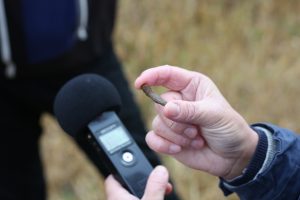
We recorded the testing also with Dictaphones. Kuva/Photo: Ville Rohiola.
Each detectorist had either Anna Wessman, Helinä Parviainen or Suzie Thomas accompanying them with a Dictaphone to record their impressions and have them talk through the recording process on FindSampo – noting where there were still issues in the process (for example steps taking too long to complete still), and to notice practical challenges that can be fixed. Ville Rohiola was on hand taking many photographs to document the event, and Pejam Hassanzadeh with Mikko Koho and Jouni Tuominen were on hand to see for themselves how the app works in the hands of detectorists, and to assist with technical issues and questions.
With metal detectors borrowed from the Archaeology section of the Department of Cultures, Mikko and Jouni also tried out metal detecting for themselves, and also tested using FindSampo as absolute beginners – benefiting also from the expert coaching of the detectorists! They will continue to test the app next week on the Otaniemi Campus of Aalto University, keeping the metal detectors for a little longer.
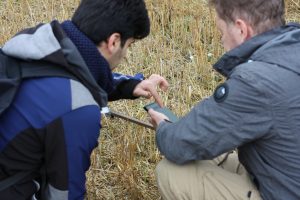
Pejam is assisting Anssi Puisto with FindSampo. Photo: Ville Rohiola.
Feedback helped pinpoint issues in the still-developing FindSampo app, for example that photos taken of the find and the surrounding area take a bit too long to upload, and the personal gallery of finds that users create as they record more finds could have thumbnail pictures to help differentiate which find is which later on. On the whole though, feedback was positive and encouraging, and one detectorist noted having used the Dutch system PAN that in that case there is as of yet no app available, so FindSampo is definitely a step in the right direction in terms of encouraging detectorists and others to report their finds quickly and efficiently.

Matti Mölsä reporting a testfind while Pejam Hassanzadeh is following the process. Photo: Helinä Parviainen
For Pejam this session, and the essential debrief afterwards with coffee and sandwiches, was especially crucial as the feedback feeds into his Masters dissertation, as well as helping to improve and enhance FindSampo itself.
